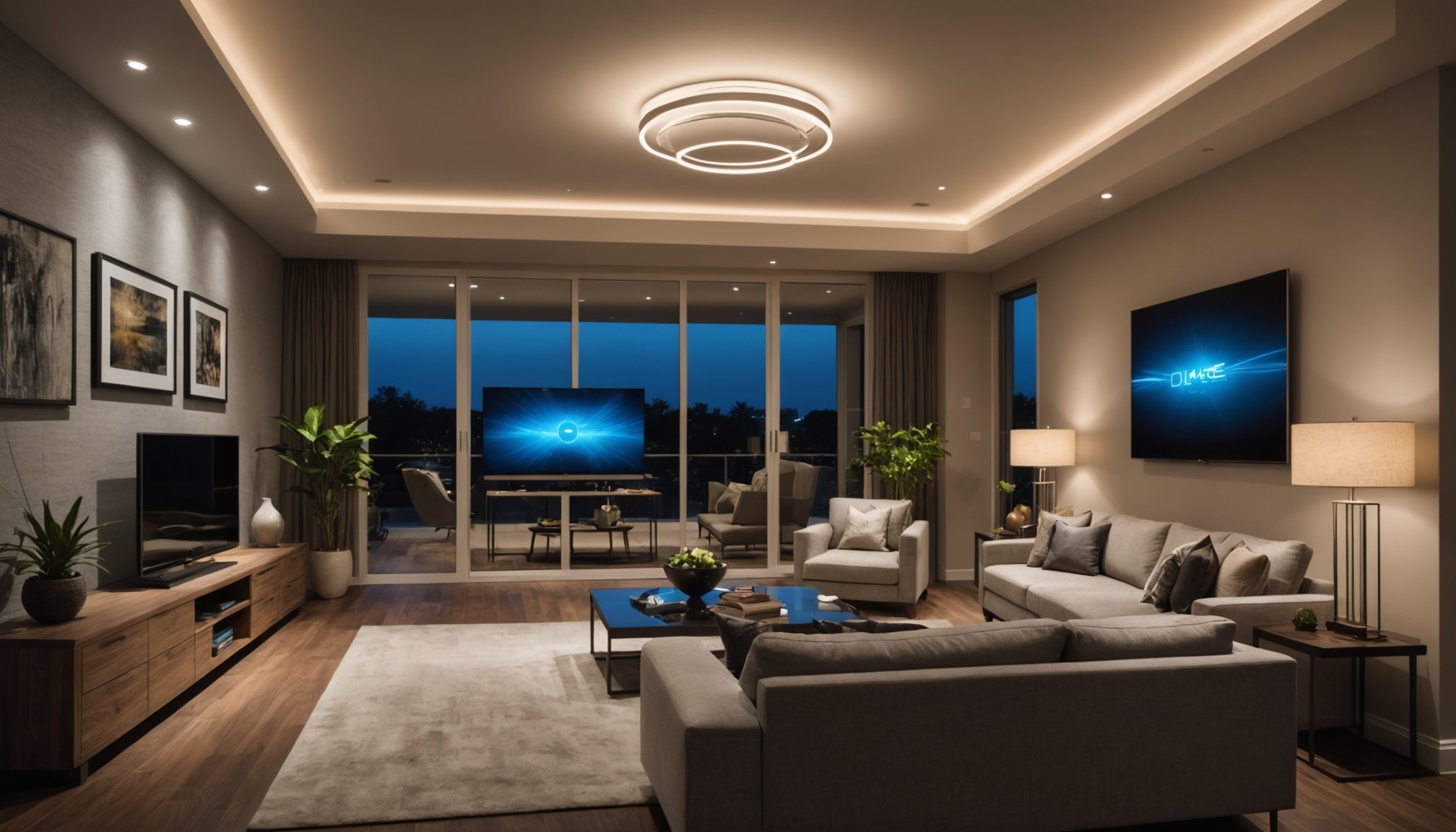Unleash the Power of Smart Lighting: Top Solutions for Your Home Automation Setup
In the era of smart home technology, one of the most transformative and accessible upgrades you can make to your home is smart lighting. Not only does it enhance the ambiance and functionality of your space, but it also offers significant benefits in terms of energy efficiency, security, and convenience. Here’s a comprehensive guide to help you navigate the world of smart lighting and find the best solutions for your home automation setup.
Why Smart Lighting?
Before diving into the specifics, it’s essential to understand why smart lighting is a game-changer for your home.
This might interest you : Essential pest-deterring plants for a flourishing vegetable garden at home
Energy Efficiency
Smart lighting systems are designed to be energy-efficient. For instance, bulbs like those from Philips Hue and IKEA TRÅDFRI use LED technology, which consumes significantly less energy compared to traditional incandescent bulbs. These systems also allow you to control the brightness and color of your lights, further reducing energy consumption[1][4].
Enhanced Security
Smart lighting can play a crucial role in home security. You can program your lights to turn on and off at specific times, creating the illusion that someone is home even when you’re away. This can be particularly effective when integrated with other smart devices like security cameras.
This might interest you : Discover the best calming plants to turn your urban terrace into a relaxing oasis
Convenience and Control
One of the most appealing aspects of smart lighting is the level of control it offers. With apps like Home Assistant, you can control your lights from anywhere, adjust their color and brightness, and even automate lighting scenes based on your daily routines[2].
Top Smart Lighting Solutions
Here are some of the best smart lighting solutions available in the market, each with its unique features and benefits.
Philips Hue: The Gold Standard
Philips Hue is often considered the benchmark for smart lighting. Here’s why:
- Rich Ecosystem: Philips Hue offers an extensive range of products, including bulbs, light strips, and outdoor lighting. Their system uses ZigBee protocol and requires a hub to manage up to 50 devices[1].
- Software Excellence: The Philips Hue app is highly functional, with numerous third-party integrations and an API for developers. Recent updates have introduced brighter bulbs and improved features, although some users have noted a less intuitive interface[1].
- Compatibility: Philips Hue integrates seamlessly with major smart home systems, including Apple HomeKit, Google Assistant, and Amazon Alexa.
### Why Choose Philips Hue?
- Rich ecosystem with numerous product options
- Excellent software with third-party integrations
- High-quality light with good color rendering
- Compatible with major smart home systems
IKEA TRÅDFRI: Budget-Friendly Excellence
IKEA’s TRÅDFRI range is a budget-friendly alternative that doesn’t compromise on quality.
- Affordability: TRÅDFRI bulbs are significantly cheaper than their Philips Hue counterparts, making them an excellent choice for those on a budget. A color bulb from TRÅDFRI costs about three times less than a similar Philips Hue bulb[1].
- Ease of Installation: The setup is straightforward, although you need to purchase a separate remote control. The bulbs use ZigBee protocol and are compatible with other ZigBee systems, including Philips Hue[1].
- Solid App: The TRÅDFRI app is robust and integrates well with other smart home assistants, though it lacks a developer SDK.
### Why Choose IKEA TRÅDFRI?
- Highly affordable
- Easy installation
- Solid app with good compatibility
- Excellent value for money
Xiaomi Yeelight 1S: Wi-Fi Convenience
For those who prefer a Wi-Fi-based solution without the need for a hub, the Xiaomi Yeelight 1S is a great option.
- No Hub Required: Unlike Philips Hue and IKEA TRÅDFRI, the Yeelight 1S connects directly to your Wi-Fi network, eliminating the need for a separate hub[1].
- Good Color Rendering: The Yeelight 1S boasts an excellent Indice de Rendu des Couleurs (IRC), ensuring vibrant and accurate colors.
- Affordability: It’s a cost-effective solution, especially if you only need a few bulbs.
### Why Choose Xiaomi Yeelight 1S?
- No need for a hub
- Good IRC for vibrant colors
- Affordable option
TP-Link KL110 Kasa: Simple and Versatile
TP-Link’s KL110 Kasa is another user-friendly option that integrates well with various smart home systems.
- Easy Installation: The KL110 Kasa does not require a hub and can be set up using the Kasa app. It’s compatible with Wi-Fi and works with voice assistants like Alexa, Google Assistant, and Cortana[1].
- Customizable Scenes: You can create custom lighting scenes and schedules using the app, making it a versatile choice for daily use.
- Compatibility: It integrates well with other smart devices and supports both iOS and Android.
### Why Choose TP-Link KL110 Kasa?
- Easy installation without a hub
- Customizable scenes and schedules
- Compatible with major voice assistants
Smart Lighting Systems Comparison
Here’s a detailed comparison of some of the top smart lighting systems:
| Feature | Philips Hue | IKEA TRÅDFRI | Xiaomi Yeelight 1S | TP-Link KL110 Kasa |
|---|---|---|---|---|
| Protocol | ZigBee | ZigBee | Wi-Fi | Wi-Fi |
| Hub Required | Yes | Yes | No | No |
| Compatibility | HomeKit, Alexa, Google Assistant | HomeKit, Alexa, Google Assistant | Alexa, Google Assistant | Alexa, Google Assistant, Cortana |
| Color Options | White and Color | White and Color | White and Color | White |
| IRC | Excellent | Good | Excellent | Good |
| Price | High | Low | Medium | Medium |
| App Features | Rich, third-party integrations | Solid, limited developer options | User-friendly, customizable scenes | User-friendly, customizable scenes |
Integrating Smart Lighting with Home Automation
One of the key benefits of smart lighting is its ability to integrate seamlessly with other smart home devices.
Home Assistant: The Ultimate Control Center
Home Assistant is an excellent platform for managing all your smart home devices, including your lighting. Here’s why it stands out:
- Device Discovery: Home Assistant can automatically discover and configure new devices, making setup a breeze[2].
- Automation: You can automate various tasks, such as dimming lights when you start watching a movie or turning off lights when you leave the house.
- Privacy: Home Assistant keeps your data private, allowing you to view past trends and averages without compromising your security.
- Compatibility: It supports a wide range of protocols, including ZigBee, Z-Wave, Matter, and Thread.
### Why Use Home Assistant?
- Automatic device discovery
- Comprehensive automation capabilities
- Data privacy
- Wide protocol compatibility
Practical Tips for Setting Up Your Smart Lighting
Here are some practical tips to help you get the most out of your smart lighting setup:
Start Small
Begin with a starter kit or a few bulbs to get a feel for how smart lighting works. This will also help you understand the ecosystem and any potential compatibility issues.
Choose the Right Hub
If you opt for a system that requires a hub (like Philips Hue or IKEA TRÅDFRI), ensure it is placed in a central location to maximize signal strength.
Use Voice Control
Integrate your smart lights with voice assistants like Alexa or Google Assistant for hands-free control. This can be particularly useful for creating quick lighting scenes or adjusting brightness on the go.
Automate Your Lights
Use the automation features of your smart lighting app to create custom scenes and schedules. For example, you can set your lights to turn on when you enter a room or adjust their brightness based on the time of day.
Smart lighting is more than just a fancy upgrade; it’s a transformative way to enhance your home’s ambiance, security, and energy efficiency. Whether you choose the comprehensive ecosystem of Philips Hue, the budget-friendly options of IKEA TRÅDFRI, or the Wi-Fi convenience of Xiaomi Yeelight 1S, there’s a smart lighting solution out there for everyone.
By integrating your smart lights with other smart home devices and using platforms like Home Assistant, you can unlock the full potential of your home automation setup. So, take the first step today and unleash the power of smart lighting in your home. As a user of Philips Hue aptly put it, “Smart lighting has changed the way I live in my home. It’s not just about turning lights on and off; it’s about creating an experience.”[1]
With the right smart lighting system, you can control your lights, enhance your home’s security, and save energy—all from the comfort of your smartphone or with a simple voice command. Welcome to the future of home automation, where smart lighting is just the beginning.

